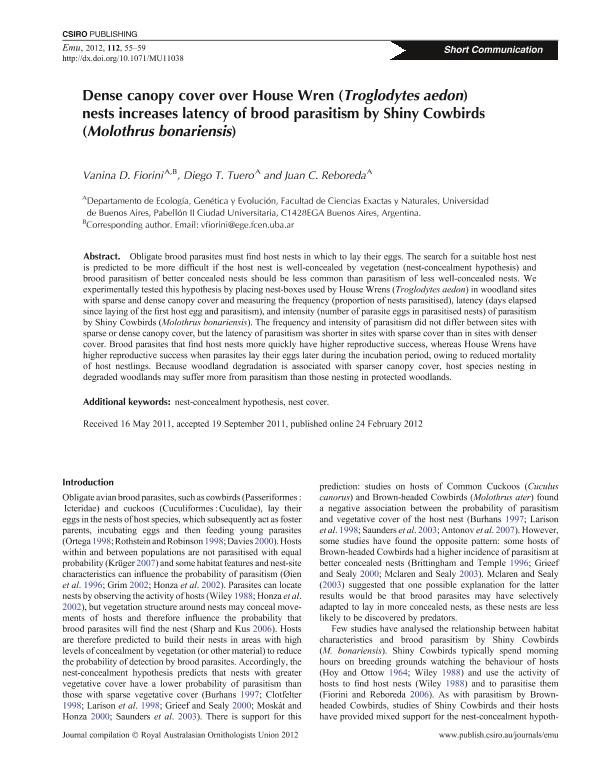Mostrar el registro sencillo del ítem
dc.contributor.author
Fiorini, Vanina Dafne

dc.contributor.author
Tuero, Diego Tomas

dc.contributor.author
Reboreda, Juan Carlos

dc.date.available
2019-01-17T21:03:19Z
dc.date.issued
2012-02
dc.identifier.citation
Fiorini, Vanina Dafne; Tuero, Diego Tomas; Reboreda, Juan Carlos; Dense canopy cover over House Wren (Troglodytes aedon) nests increases latency of brood parasitism by Shiny Cowbirds (Molothrus bonariensis); Csiro Publishing; Emu; 112; 1; 2-2012; 55-59
dc.identifier.issn
0158-4197
dc.identifier.uri
http://hdl.handle.net/11336/68233
dc.description.abstract
Obligate brood parasites must find host nests in which to lay their eggs. The search for a suitable host nest is predicted to be more difficult if the host nest is well-concealed by vegetation (nest-concealment hypothesis) and brood parasitism of better concealed nests should be less common than parasitism of less well-concealed nests. We experimentally tested this hypothesis by placing nest-boxes used by House Wrens (Troglodytes aedon) in woodland sites with sparse and dense canopy cover and measuring the frequency (proportion of nests parasitised), latency (days elapsed since laying of the first host egg and parasitism), and intensity (number of parasite eggs in parasitised nests) of parasitism by Shiny Cowbirds (Molothrus bonariensis). The frequency and intensity of parasitism did not differ between sites with sparse or dense canopy cover, but the latency of parasitism was shorter in sites with sparse cover than in sites with denser cover. Brood parasites that find host nests more quickly have higher reproductive success, whereas House Wrens have higher reproductive success when parasites lay their eggs later during the incubation period, owing to reduced mortality of host nestlings. Because woodland degradation is associated with sparser canopy cover, host species nesting in degraded woodlands may suffer more from parasitism than those nesting in protected woodlands.
dc.format
application/pdf
dc.language.iso
eng
dc.publisher
Csiro Publishing

dc.rights
info:eu-repo/semantics/openAccess
dc.rights.uri
https://creativecommons.org/licenses/by-nc-sa/2.5/ar/
dc.subject
Nest Cover
dc.subject
Nest-Concealment Hypothesis
dc.subject.classification
Otras Ciencias Biológicas

dc.subject.classification
Ciencias Biológicas

dc.subject.classification
CIENCIAS NATURALES Y EXACTAS

dc.title
Dense canopy cover over House Wren (Troglodytes aedon) nests increases latency of brood parasitism by Shiny Cowbirds (Molothrus bonariensis)
dc.type
info:eu-repo/semantics/article
dc.type
info:ar-repo/semantics/artículo
dc.type
info:eu-repo/semantics/publishedVersion
dc.date.updated
2019-01-17T13:55:28Z
dc.journal.volume
112
dc.journal.number
1
dc.journal.pagination
55-59
dc.journal.pais
Australia

dc.journal.ciudad
Collingwood
dc.description.fil
Fil: Fiorini, Vanina Dafne. Universidad de Buenos Aires. Facultad de Ciencias Exactas y Naturales. Departamento de Ecología, Genética y Evolución. Laboratorio de Ecología y Comportamiento Animal; Argentina. Consejo Nacional de Investigaciones Científicas y Técnicas; Argentina
dc.description.fil
Fil: Tuero, Diego Tomas. Universidad de Buenos Aires. Facultad de Ciencias Exactas y Naturales. Departamento de Ecología, Genética y Evolución. Laboratorio de Ecología y Comportamiento Animal; Argentina. Consejo Nacional de Investigaciones Científicas y Técnicas; Argentina
dc.description.fil
Fil: Reboreda, Juan Carlos. Universidad de Buenos Aires. Facultad de Ciencias Exactas y Naturales. Departamento de Ecología, Genética y Evolución. Laboratorio de Ecología y Comportamiento Animal; Argentina. Consejo Nacional de Investigaciones Científicas y Técnicas; Argentina
dc.journal.title
Emu

dc.relation.alternativeid
info:eu-repo/semantics/altIdentifier/url/https://www.tandfonline.com/doi/abs/10.1071/MU11038
dc.relation.alternativeid
info:eu-repo/semantics/altIdentifier/doi/http://dx.doi.org/10.1071/MU11038
Archivos asociados
